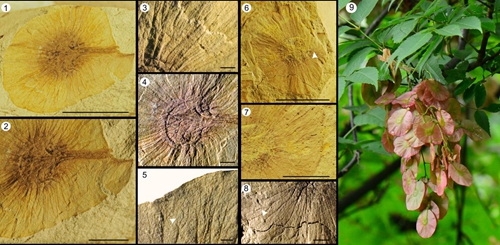Dipteronia (Sapindaceae) is an ancient relictual woody genus in East Asia and is endemic to southern and central China with two extant species: Dipteronia sinensis and Dipteronia dyeriana. Compared to its modern restricted distribution, Dipteronia was present in the Far East and North America during the Palaeogene. However, when Dipteronia migrated to China and where it came from were still unknown due to the lacking fossil record.
In a new study published in Review of Palaeobotany and Palynology, researchers from Paleoecology Group of Xishuangbanna Tropical Botanical Garden (XTBG) present a newly discovered fossil occurrence of Dipteronia fruits from the early Oligocene (about 33.9 million to 23 million years ago) of Yunnan, southwestern China.
The researchers collected fossil dicotyledonous leaves and two winged fruits of Dipteronia in lacustrine mudstones near Lühe Town (25°8.5′N, 101°22.5′E,), Chuxiong Yi Autonomous Prefecture, Yunnan Province.
They studied the fossil fruits morphologically and compared with both extant and fossil representatives of Dipteronia. The fossils show combined characteristics of Dipteronia sinensis and Dipteronia brownii and fall within the range of morphological variability of D. brownii. Therefore, the researchers adopt a broad circumscription and assign their fossils to D. brownii.
Dipteronia fruit fossils fall within the range of variation in general size and shape of Dipteronia sinensis, which demonstrates that the genus has retained its unique fruit morphology since the Palaeogene. Therefore, the central and southern regions of China, which experienced relative tectonic and climatic stability, provided suitable habitats for these palaeoendemic taxa
The new fossil discovery suggests that the palaeoendemic genus Dipteronia was widely distributed in North America and Asia during the Palaeogene, and had existed in southwestern China by the Rupelian.
Contact
ZHOU Zhekun, Ph.D
Key Laboratory of Tropical Forest Ecology, Xishuangbanna Tropical Botanical Garden, Chinese Academy of Sciences, Mengla, Yunnan 666303, China
Tel: 86-871-65109223
E-mail: zhouzk@xtbg.ac.cn

Fossil of Dipteronia brownii and extant Dipteronia browni.
(Images by DING Wenna)

